
Giovanni Francesco Barbieri, better known as Guercino, or il Guercino[ɡwerˈtʃiːno], was an Italian Baroque painter and draftsman from Cento in the Emilia region, who was active in Rome and Bologna. The vigorous naturalism of his early manner contrasts with the classical equilibrium of his later works. His many drawings are noted for their luminosity and lively style.

Carlo Cignani was an Italian painter. His innovative style referred to as his 'new manner' introduced a reflective, intimate mood of painting and presaged the later pictures of Guido Reni and Guercino, as well as those of Simone Cantarini. This gentle manner marked a break with the more energetic style of earlier Bolognese classicism of the Bolognese School of painting.

Cento is a town and comune in the province of Ferrara, Emilia-Romagna, Italy.

Giuseppe Maria Crespi, nicknamed Lo Spagnuolo, was an Italian late Baroque painter of the Bolognese School. His eclectic output includes religious paintings and portraits, but he is now most famous for his genre paintings.

Francesco Vanni was an Italian painter, draughtsman, printmaker, publisher and printer active in Rome and his native city of Siena.
The School of Ferrara was a group of painters which flourished in the Duchy of Ferrara during the Renaissance. Ferrara was ruled by the Este family, well known for its patronage of the arts. Patronage was extended with the ascent of Ercole d'Este I in 1470, and the family continued in power till Alfonso II, Ercole's great-grandson, died without an heir in 1597. The duchy was then occupied in succession by Papal and Austrian forces. The school evolved styles of painting that appeared to blend influences from Mantua, Venice, Lombardy, Bologna, and Florence.
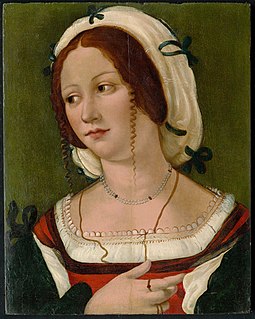
The Bolognese School or the School of Bologna of painting flourished in Bologna, the capital of Emilia Romagna, between the 16th and 17th centuries in Italy, and rivalled Florence and Rome as the center of painting. Its most important representatives include the Carracci family, including Ludovico Carracci and his two cousins, the brothers Agostino and Annibale Carracci. Later, it included other Baroque painters: Domenichino and Lanfranco, active mostly in Rome, eventually Guercino and Guido Reni, and Accademia degli Incamminati in Bologna, which was run by Lodovico Carracci. Certain artistic conventions, which over time became traditionalist, had been developed in Rome during the first decades of the 16th century. As time passed, some artists sought new approaches to their work that no longer reflected only the Roman manner. The Carracci studio sought innovation or invention, seeking new ways to break away from traditional modes of painting while continuing to look for inspiration from their literary contemporaries; the studio formulated a style that was distinguished from the recognized manners of art in their time. This style was seen as both systematic and imitative, borrowing particular motifs from the past Roman schools of art and innovating a modernistic approach.

Alessandro Tiarini was an Italian Baroque painter of the Bolognese School.

Marcantonio Franceschini was an Italian painter of the Baroque period, active mostly in his native Bologna. He was the father and teacher of Giacomo Franceschini.

The Basilica of San Domenico is one of the major churches in Bologna, Italy. The remains of Saint Dominic, founder of the Order of Preachers (Dominicans), are buried inside the exquisite shrine Arca di San Domenico, made by Nicola Pisano and his workshop, Arnolfo di Cambio and with later additions by Niccolò dell'Arca and the young Michelangelo.
Benedetto Gennari (1563–1610) was an Italian painter of the early-Baroque period, active mainly in Ferrara and Cento.
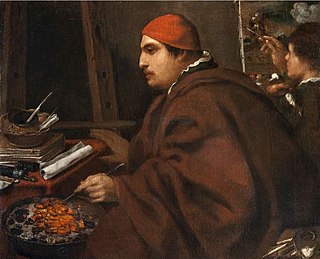
Giuseppe Caletti or Calletti was an Italian painter and engraver of the Baroque period, active in Ferrara and Cremona. He often painted religious themes in a genre like dress and surroundings, including the theme of Bacchanalia like Titian.

Cesare Gennari was an Italian painter of the Baroque period. His Saint Mary Magdalene is in the Pinacoteca Civica di Cento. His Apparition of the Virgin to Saint Nicholas of Bari is at the Pinacoteca di Bologna.
Francesco Bassi was an Italian painter active in the early-Baroque period, mainly in his hometown of Cremona, but also in Venice. He was also known as Francesco Maria Bassi the elder.
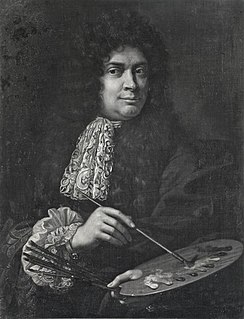
Benedetto Gennari II was an Italian painter active during the Baroque period.

San Giovanni in Monte is a 15th-century Roman Catholic church in Bologna, Italy.

Domenico Pedrini was an Italian painter. Fiercely provincial in his geographic activity, Pedrini's works were mainly completed in and around Bologna, and yet his atavistic style strayed far afield into Bologna's strong Baroque ancestry.
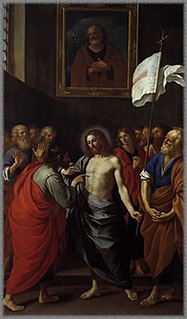
Bartolomeo Gennari was an Italian Renaissance painter.
Lorenzo Gennari was an Italian painter.
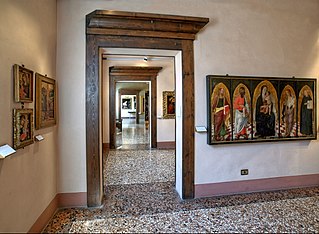
The Pinacoteca Domenico Inzaghi is an art museum, exhibiting mainly paintings and engravings, located in Palazzo della Partecipanza, Via Mentana 32, in Budrio, Italy.

















